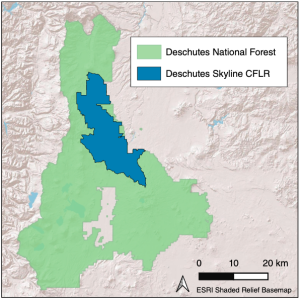The Influence of Wildfire Risk Reduction Programs and Practices on Recreation Visitation
Citation
White, E. M., Winder, S. G., & Wood, S. A. (2024). The influence of wildfire risk reduction programs and practices on recreation visitation. International Journal of Wildland Fire, 33(12). doi.org/10.1071/WF24036
We still know very little about how forest management activities that reduce wildfire risk (e.g., thinning trees, removing fuels, etc.) affect recreation in those same areas. One reason for this gap is that most government programs that track recreation on public lands collect data at very broad scales and infrequently, which makes it hard to see local or short-term changes connected to specific forest treatments.
New tools that use digital information shared by the public (e.g., social media posts, mobile apps, etc.) have made it possible to track recreation patterns in much greater detail. These volunteered geographic information (VGI) sources can help researchers understand how people respond to land management actions, even in places without on-site visitor surveys.
In this study, the authors used VGI from social media to explore how recreation use changed in areas where the U.S. Collaborative Forest Landscape Restoration (CFLR) Program funded wildfire risk reduction projects. Between 2010 and 2020, the CFLR Program supported 23 large forest restoration efforts across US national forests.
This research aims to understand:
- Whether recreation patterns changed after wildfire risk reduction projects began.
- Whether different types or levels of fuel treatment influence visitation.
The findings will help researchers and land managers improve their understanding of how fire risk reduction programs and fuel treatment activities influence recreation use.
Abstract

Background
The increasing extent and severity of uncharacteristic wildfire has prompted numerous policies and programs promoting landscape-scale fuels reduction.
Aims
We used novel data sources to measure how recreation was influenced by fuels reduction efforts under the US Forest Service Collaborative Forest Landscape Restoration (CFLR) Program.
Methods
We used posts to four social media platforms to estimate the number of social media user-days within CFLR landscapes and asked: (1) did visitation within CFLR Program landscapes between 2012 and 2020 change in a manner consistent with the pattern on nearby lands, and (2) was there a relationship between the magnitudes of specific fuel treatment activities within CFLR landscapes and visitation to that landscape?
Key results
In aggregate, visitation to the CFLR landscapes changed at a rate mirroring the trend observed elsewhere. Within CFLR landscapes, pre-commercial thinning and pruning had slight positive influences on visitation whereas prescribed burning and managed wildfire had slight negative influences.
Conclusions
Fuel treatments can have a modest influence on visitation, but we didnot find any wholesale changes in visitation within CFLR landscapes.
Implications
Social media and other novel data sources offer an opportunity to fill in gaps in empirical data on recreation to better understand social-ecological system linkages.